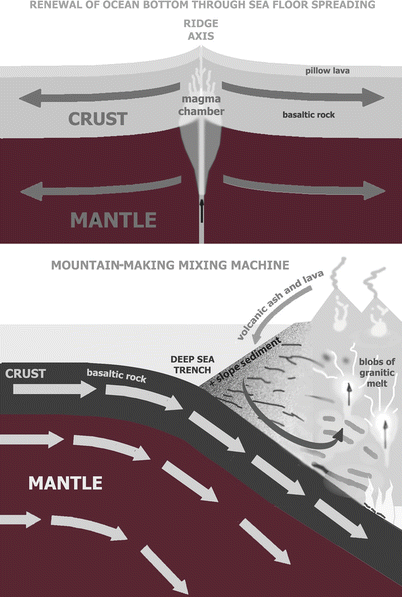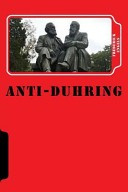1.1.1 General Background Information
There were an enormous number of striking geologic discoveries made and geologic theories created in the twentieth century. All of these bear importantly on marine geology. Four findings stand out: (1) plate tectonics (linked to continental drift and based largely on the geomorphology of the seafloor, geomagnetism surveys, heat flow patterns, and earthquakes at sea), (2) Orbital Ice Age Theory (informed by solar system astronomy and confirmed by the study of deep-sea sediment), (3) stepwise Cenozoic cooling (based on results from deep-sea drilling), and (4) confirmation of the impact theory for the end of the Mesozoic (clinched by stratigraphy of pelagic sediments on land). The respective widely recognized pioneers are (1) a number of largely US American and British geologists, geophysicists, and geomagnetists (e.g., Lamonts marine geologist Bruce Heezen (19241977), the US Navys Robert Dietz (19141995) and Harry Hess (19061969), the UK geophysicist Fred Vine (Ph.D. 1965, Cambridge)), and also the German meteorologist Alfred Wegener (18801930); (2) Milutin Milankovitch (18791958), Serbian astronomer and civil engineer, and two astronomers (John Stockwell and Urbain Leverrier) delivering input to his calculations (The leading contemporaneous proponent of orbital forcing is Andr Berger, Belgian astronomer and climatologist.); (3) contemporaneous pioneers are the NZ-US marine geologist James P. Kennett (Ph.D. 1965, Wellington), the British geophysicist Nick Shackleton (19372006), the isotope chemist Sam Savin (Ph.D. 1967, Pasadena), and the geologist Robert Douglas (Ph.D. 1966, U.C. Los Angeles); and (4) the impact pioneers are the German-Swiss geologist and paleontologist Hanspeter Luterbacher, the Italian geologist Isabella Premoli Silva, and the Californian physicist Luis Alvarez (19111988) and his geologist son Walter (Berkeley) and their associates F. Asaro (19272014) and H. Michel (Berkeley). The crucial papers and books were published (1) in the 1920s and 1960s ( Continental Drift and Plate Tectonics ), (2) in the 1920s and 1980s (Orbital Ice Age Theory, proposed and verified), (3) in the 1970s (microfossils and oxygen isotopes), and (4) in the 1960s and 1980s (sudden end-of-Cretaceous mass extinction documented in pelagic sediments on land surveyed and iridium maximum found, respectively).
What, if anything, do the four great revolutions have in common?
They emphasize the control of geologic history by outside forcing, either endogenic (processes driven by mantle convection) or astronomic ones controlled by solar system phenomena and a call on positive feedback for amplification (negative feedback stabilizes).
The discovery of the great importance of outside forcing (including the unpredictable and highly variable factors of earthquakes, volcanism, and collisions in space) has resulted in some discrimination against regular surficial Earth processes, which have considerably damaged the perception that the pronouncements of the British lawyer Charles Lyell (17971875) regarding uniformitarianism (a long bastion of textbook geology) hold water. His central concept, that the present is the key to the past, became suspect as a dominating rule in the interpretation of the geologic record, especially in an ice age. The same is true for the reverse assertion that the past is the key to the present (or to the future). Endogenic forces are difficult to observe, being generated in the mantle of the planet. While regular astronomic forcing can be calculated with great precision, it is not necessarily well understood in its applications to a complicated Earth response.
In system analysis (which started as a concept in engineering), negative feedback drives a system toward original conditions during episodes of change. Negative feedback favors the status quo . The idea of negative feedback of a chemical system is the backbone of Le Chateliers Principle, proclaimed many decades ago by the French pioneer chemist Henry Louis Le Chatelier (18501936) and soon after elaborated for the Earth system by the Russian-French geochemist Vladimir Vernadsky (18631945). The daisyworld model of the UK chemist James Lovelock (Ph.D. 1948, London) beautifully illustrates the negative feedback concept. Positive feedback, in contrast, increases any change and eventually leads to blowout if not checked. As a corollary, when positive (non-Gaian, K.J. Hs) feedback is at work, relatively modest forcing can result in enormously large changes. In a very general way, negative feedback supports Lyell and Gaia and traditional geologic thinking going back almost two centuries, while positive feedback does not: it produces unexpected results and abrupt change and tends to be rather hazardous, therefore.
1.1.2 Plate Tectonics and Endogenic Forcing
A little more than half a century ago, it was still possible to think that sediments on the deep seafloor offer information for the entire Phanerozoic, that is, the last half billion years. In fact, some geologists thought the deep-sea record might lead us back even into the Precambrian, into times a billion years ago, or more. Today, it is no longer possible to harbor such thoughts. The deep seafloor is young, geologically speaking. The most ancient sediments recovered are about 150 million years old, that is, less than 5% of the age accorded to ancient rocks on land. Deep-sea deposits older than Jurassic presumably existed at some point, but it is thought that they vanished, entering the mantle by subduction in trenches.
The main relevant activity providing for the forcing of plate tectonics is in the mantle of Earth (Fig. ). It is not known just how the mantle operates in the context of plate tectonics.
Fig. 1.1
The main elements of the planets structure, not to scale and hypothetical regarding mantle motion. Roughly one half of the Earth is mantle; crust is negligible by volume, in comparison. The mantle convects, largely in unknown ways. Alternatively to the picture shown, fast convection may be restricted to an upper layer, while convection in the lower mantle is much slower. The lithosphere (the stiff uppermost part of the mantle) is roughly 100 km thick. Together with the crust, it defines the plates (Background graph courtesy of S.I.O. Aquarium Education Program, here modified)
Seafloor spreading is responsible for the world-encircling mid-ocean ridge and for the Atlantic. Volcanic activity associated with subduction (Fig. ) but also on the northern West Coast of the USA, in Alaska, and in Japan. Earthquakes generated in the subduction belts can and do produce tsunamis, that is, waves that travel on the surface of the ocean at the speed of jet aircraft and that grow to enormous size in shallow water.
Fig. 1.2
The crux of modern global tectonics involving the seafloor. Upper panel : seafloor spreading; lower panel : seafloor subduction. The latter involves the making of mountain chains. The assumption is that creation and destruction of seafloor are balanced, so that Earth does not change its size. The downward-going lithospheric slab (about 100 km thick) eventually dissolves within the mantle. Drawing is not to scale (After W. H. Berger 2009, Ocean. U. of California Press, Berkeley, with some minor modifications)













